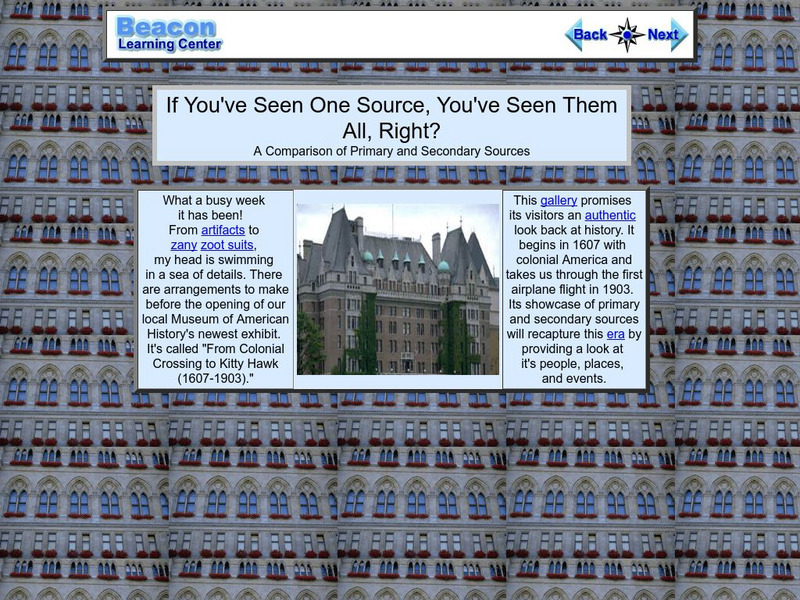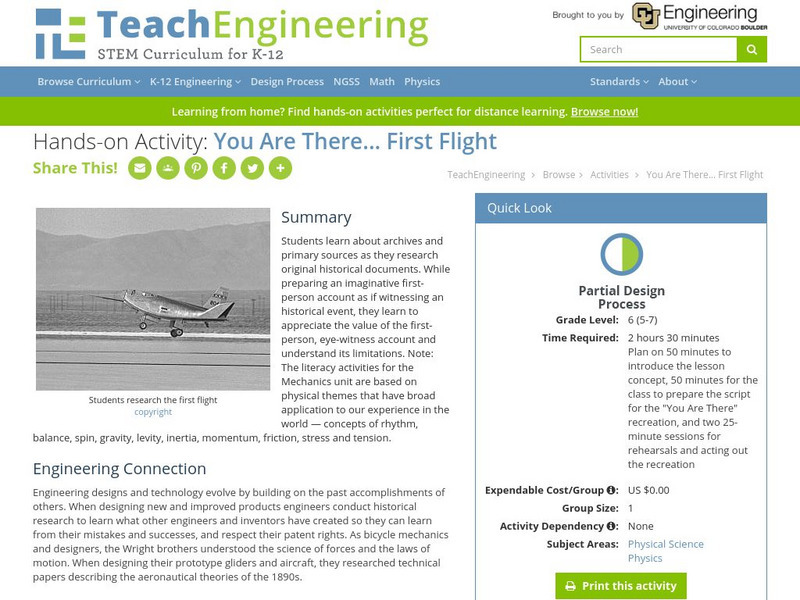Hi, what do you want to do?
EngageNY
TASC Transition Curriculum: Workshop 12
How can opinions slant facts? Workshop participants learn how to examine primary and secondary sources and identify the author's point of view. They also examine how visual art impacts the meaning and rhetoric of sources. Full of...
New York State Education Department
TASC Transition Curriculum: Workshop 11
You'll C-E-R a difference in classroom achievement after using a helpful instructional activity. Designed for economics, civics, government, and US history classes, participants practice using the CER model to craft arguments about...
University of California
Uc Irvine: Distinguishing Between Primary & Secondary Sources
This site has an online quiz to test your knowledge of primary and secondary sources.
Library and Archives Canada
Nlc: Defining Primary and Secondary Sources
Libraries and archives hold documents and books that can be used for your research projects. Learn how to divide and identify them into primary and secondary sources in this tutorial.
Other
George W. Bush Presidential Library: Teaching Primary and Secondary Sources
This comprehensive lesson plan provides a fact sheet, reusable worksheets, source scenarios, and assessments.
Library of Congress
Loc: Teachers: Personal Stories and Primary Sources
Students will explore the value of personal stories and first-hand accounts when exploring history, in this case, the events of the early twentieth century, which included World War I and the Great Depression. Through this five-unit...
Internet History Sourcebooks Project
Fordham University: Medieval Sourcebook: History Through Primary Sources
This site from the Medieval Sourcebook answers the question: Why Study History Through Primary Sources? It provides complete information, a list of review questions, and bibliography information.
TES Global
Tes: Determining of Credibility of Online Sources
[Free Registration/Login Required] This free resource is a sheet that will help students assess the credibility of an online primary source or an online secondary source.
Beacon Learning Center
Beacon Learning Center: If You've Seen One Source, You've Seen Them All. Right?
This is a tutorial teaching the difference between primary and secondary research sources. It provides specific examples and asks students to answer questions along the way. Java is required.
Other
Library of Congress: Teaching With Primary Sources
This website is an excellent resource for teaching with primary sources. This resource features Holocaust lessons, lesson plan strategies, and podcasts.
University of California
Uc Berkeley Library: Critical Evaluation of Resources
Questions to ask yourself when determining if a source is reliable. Discusses difference between primary and secondary source. List of reference sources and links to other sites that teach you how to evaluate sources....
Ohio State University
Osu History Teaching Institute: Witchcraft in Salem
Students will examine the Salem witchcraft trials through primary and secondary sources with an emphasis on different viewpoints of the trials.
US National Archives
Nara: Teaching With Documents: Teaching With Documents
Site from National Archives provides copies of primary documents that can be used while presenting various topics in U.S. history.
University of California
Cal Heritage Collection: Using Primary Sources
This resource covers what primary sources are, where we can find them, and how we can assess them in the classroom.
TeachEngineering
Teach Engineering: You Are There, First Flight
Students learn about archives and primary sources as they research original historical documents. While preparing an imaginative first-person account as if witnessing an historical event, they learn to appreciate the value of the...
Other
Time Travelers: Teaching American History in the Northwest
This amazing resouce is actually a set of three courses in teaching American history of the Northwestern U. S. from the 1700s to the year 2000. Each course is fifteen weeks long. But the course is laid out so that you can browse any...
Other
Live Binders: Primary Source Teaching the Web 2.0 Way K 12
This learning module consists of several tools for teaching with primary and secondary resources.
South Carolina Educational Television
Know It All: Primary and Secondary Accounts
Fifth graders will use letters from the Civil War to compare and contrast primary and secondary resources.
Better Lesson
Better Lesson: Native American Petroglyphs Close Read Compare and Contrast
Students will read an article by Byron Loosle on the meaning of Native American symbols and compare that to a video clip of an actual Native American explaining the symbols. There is a difference of opinion and students will weigh both...
Roy Rosenzweig Center for History and New Media
Teaching History: Interactive Historical Thinking Poster (Secondary)
This is an interactive historical thinking poster. History is an argument about the past. Constructing a narrative about history involves several tasks: Analyzing Primary Sources, Examining Source Information,Using Evidence to Support...
Kidsource OnLine
Kid Source Online: Motivating Low Performing Adolescent Readers
An article on motivating adolescents at the high school level to become better readers. With suggestions on teaching materials and identifying reading problems. (Only available in Archive)
Smithsonian Institution
National Museum of American History: History Explorer
This website, developed by the National Museum of American History, provides standards-based online resources for teaching and learning American history. An array of teacher lessons, activities, interactive media, and artifacts tag this...
British Library
British Library: Coleridge's Kubla Khan: Composition
This activity, which aims to develop students' understanding of 'Kubla Khan' after completing an initial study of Samuel Taylor Coleridge's poem, will encourage students to make links between the poem and a number of historical sources.
AdLit
Ad lit.org: Classroom Strategies: Summarizing
Summarizing teaches students how to take a large selection of text and reduce it to the main points for a more concise understanding. Upon reading a passage, summarizing helps students learn to determine essential ideas and consolidate...



















